2023 FORD MAVERICK snow chains
[x] Cancel search: snow chainsPage 15 of 556
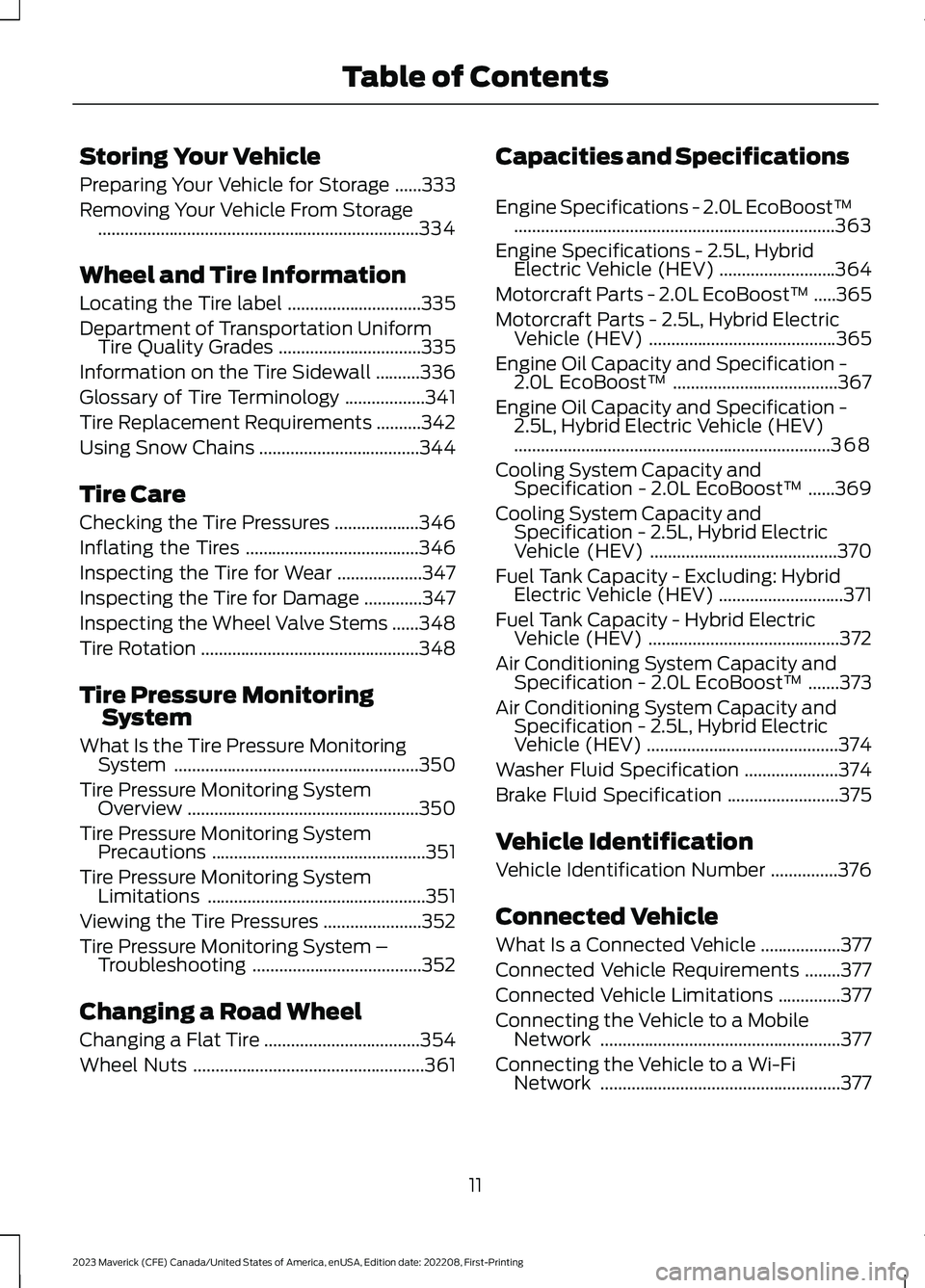
Storing Your Vehicle
Preparing Your Vehicle for Storage......333
Removing Your Vehicle From Storage........................................................................334
Wheel and Tire Information
Locating the Tire label..............................335
Department of Transportation UniformTire Quality Grades................................335
Information on the Tire Sidewall..........336
Glossary of Tire Terminology..................341
Tire Replacement Requirements..........342
Using Snow Chains....................................344
Tire Care
Checking the Tire Pressures...................346
Inflating the Tires.......................................346
Inspecting the Tire for Wear...................347
Inspecting the Tire for Damage.............347
Inspecting the Wheel Valve Stems......348
Tire Rotation.................................................348
Tire Pressure MonitoringSystem
What Is the Tire Pressure MonitoringSystem.......................................................350
Tire Pressure Monitoring SystemOverview....................................................350
Tire Pressure Monitoring SystemPrecautions................................................351
Tire Pressure Monitoring SystemLimitations.................................................351
Viewing the Tire Pressures......................352
Tire Pressure Monitoring System –Troubleshooting......................................352
Changing a Road Wheel
Changing a Flat Tire...................................354
Wheel Nuts....................................................361
Capacities and Specifications
Engine Specifications - 2.0L EcoBoost™........................................................................363
Engine Specifications - 2.5L, HybridElectric Vehicle (HEV)..........................364
Motorcraft Parts - 2.0L EcoBoost™.....365
Motorcraft Parts - 2.5L, Hybrid ElectricVehicle (HEV)..........................................365
Engine Oil Capacity and Specification -2.0L EcoBoost™.....................................367
Engine Oil Capacity and Specification -2.5L, Hybrid Electric Vehicle (HEV).......................................................................368
Cooling System Capacity andSpecification - 2.0L EcoBoost™......369
Cooling System Capacity andSpecification - 2.5L, Hybrid ElectricVehicle (HEV)..........................................370
Fuel Tank Capacity - Excluding: HybridElectric Vehicle (HEV)............................371
Fuel Tank Capacity - Hybrid ElectricVehicle (HEV)...........................................372
Air Conditioning System Capacity andSpecification - 2.0L EcoBoost™.......373
Air Conditioning System Capacity andSpecification - 2.5L, Hybrid ElectricVehicle (HEV)...........................................374
Washer Fluid Specification.....................374
Brake Fluid Specification.........................375
Vehicle Identification
Vehicle Identification Number...............376
Connected Vehicle
What Is a Connected Vehicle..................377
Connected Vehicle Requirements........377
Connected Vehicle Limitations..............377
Connecting the Vehicle to a MobileNetwork......................................................377
Connecting the Vehicle to a Wi-FiNetwork......................................................377
11
2023 Maverick (CFE) Canada/United States of America, enUSA, Edition date: 202208, First-PrintingTable of Contents
Page 282 of 556
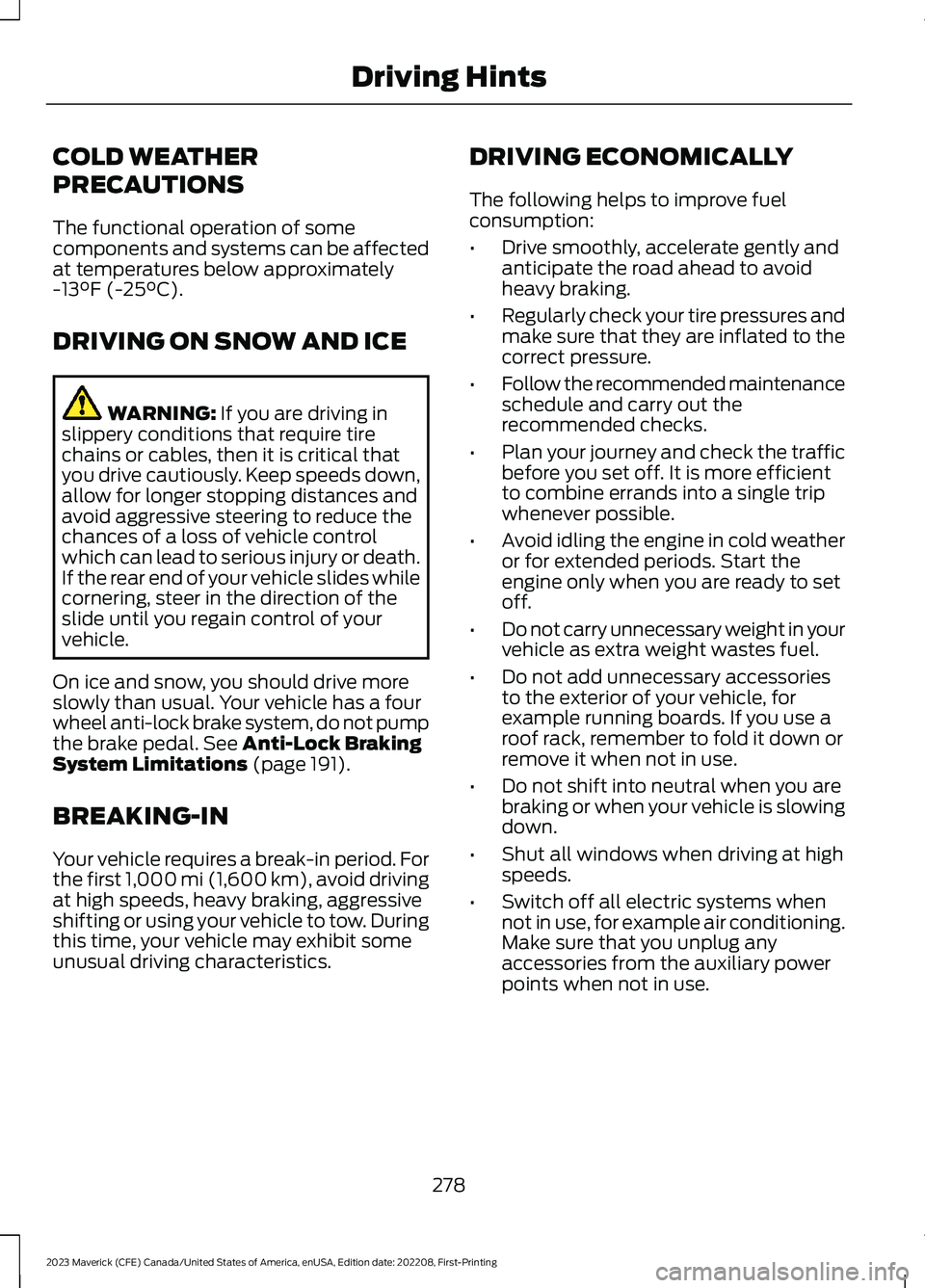
COLD WEATHER
PRECAUTIONS
The functional operation of somecomponents and systems can be affectedat temperatures below approximately-13°F (-25°C).
DRIVING ON SNOW AND ICE
WARNING: If you are driving inslippery conditions that require tirechains or cables, then it is critical thatyou drive cautiously. Keep speeds down,allow for longer stopping distances andavoid aggressive steering to reduce thechances of a loss of vehicle controlwhich can lead to serious injury or death.If the rear end of your vehicle slides whilecornering, steer in the direction of theslide until you regain control of yourvehicle.
On ice and snow, you should drive moreslowly than usual. Your vehicle has a fourwheel anti-lock brake system, do not pumpthe brake pedal. See Anti-Lock BrakingSystem Limitations (page 191).
BREAKING-IN
Your vehicle requires a break-in period. Forthe first 1,000 mi (1,600 km), avoid drivingat high speeds, heavy braking, aggressiveshifting or using your vehicle to tow. Duringthis time, your vehicle may exhibit someunusual driving characteristics.
DRIVING ECONOMICALLY
The following helps to improve fuelconsumption:
•Drive smoothly, accelerate gently andanticipate the road ahead to avoidheavy braking.
•Regularly check your tire pressures andmake sure that they are inflated to thecorrect pressure.
•Follow the recommended maintenanceschedule and carry out therecommended checks.
•Plan your journey and check the trafficbefore you set off. It is more efficientto combine errands into a single tripwhenever possible.
•Avoid idling the engine in cold weatheror for extended periods. Start theengine only when you are ready to setoff.
•Do not carry unnecessary weight in yourvehicle as extra weight wastes fuel.
•Do not add unnecessary accessoriesto the exterior of your vehicle, forexample running boards. If you use aroof rack, remember to fold it down orremove it when not in use.
•Do not shift into neutral when you arebraking or when your vehicle is slowingdown.
•Shut all windows when driving at highspeeds.
•Switch off all electric systems whennot in use, for example air conditioning.Make sure that you unplug anyaccessories from the auxiliary powerpoints when not in use.
278
2023 Maverick (CFE) Canada/United States of America, enUSA, Edition date: 202208, First-PrintingDriving Hints
Page 348 of 556
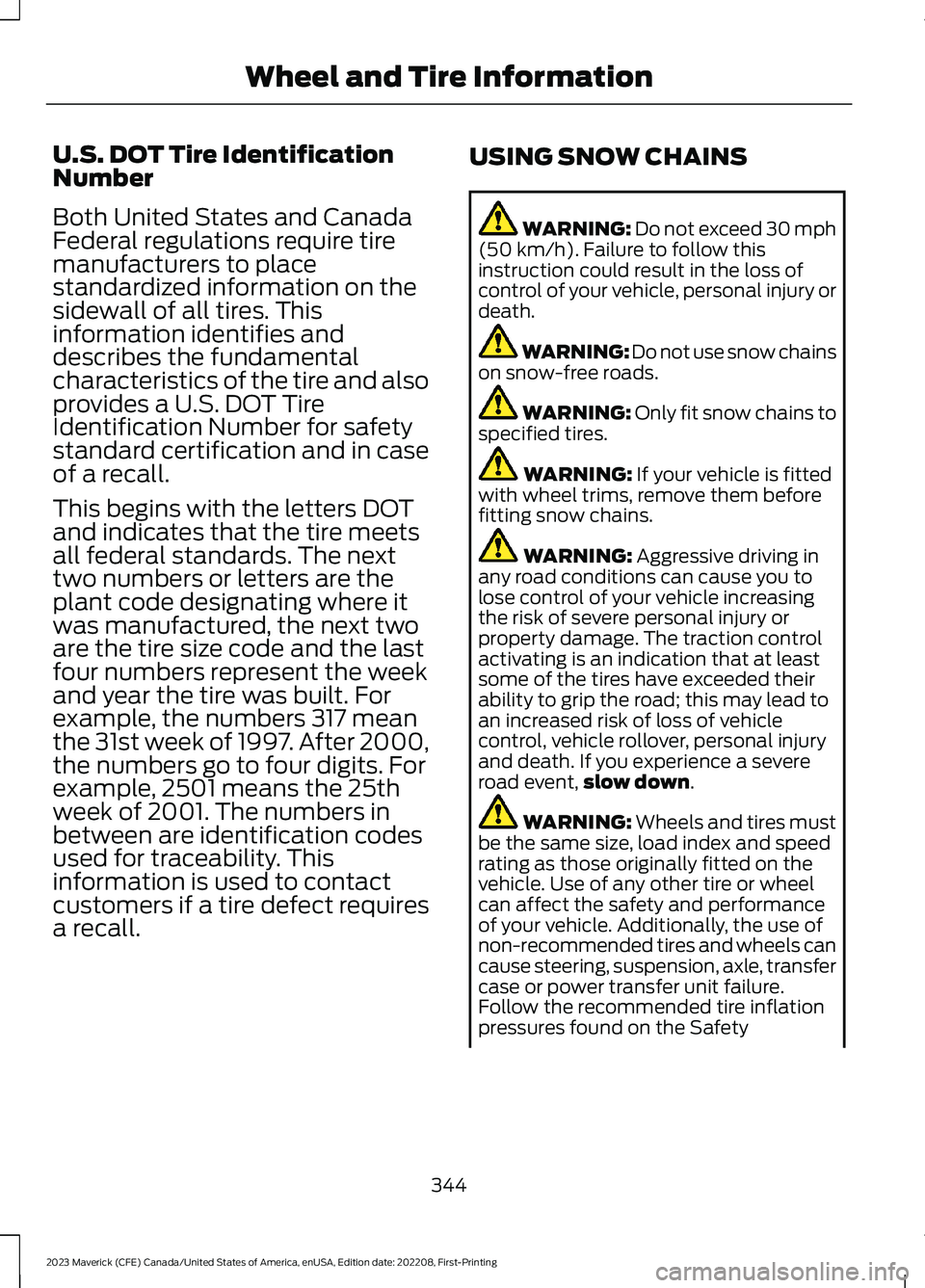
U.S. DOT Tire IdentificationNumber
Both United States and CanadaFederal regulations require tiremanufacturers to placestandardized information on thesidewall of all tires. Thisinformation identifies anddescribes the fundamentalcharacteristics of the tire and alsoprovides a U.S. DOT TireIdentification Number for safetystandard certification and in caseof a recall.
This begins with the letters DOTand indicates that the tire meetsall federal standards. The nexttwo numbers or letters are theplant code designating where itwas manufactured, the next twoare the tire size code and the lastfour numbers represent the weekand year the tire was built. Forexample, the numbers 317 meanthe 31st week of 1997. After 2000,the numbers go to four digits. Forexample, 2501 means the 25thweek of 2001. The numbers inbetween are identification codesused for traceability. Thisinformation is used to contactcustomers if a tire defect requiresa recall.
USING SNOW CHAINS
WARNING: Do not exceed 30 mph(50 km/h). Failure to follow thisinstruction could result in the loss ofcontrol of your vehicle, personal injury ordeath.
WARNING: Do not use snow chainson snow-free roads.
WARNING: Only fit snow chains tospecified tires.
WARNING: If your vehicle is fittedwith wheel trims, remove them beforefitting snow chains.
WARNING: Aggressive driving inany road conditions can cause you tolose control of your vehicle increasingthe risk of severe personal injury orproperty damage. The traction controlactivating is an indication that at leastsome of the tires have exceeded theirability to grip the road; this may lead toan increased risk of loss of vehiclecontrol, vehicle rollover, personal injuryand death. If you experience a severeroad event,slow down.
WARNING: Wheels and tires mustbe the same size, load index and speedrating as those originally fitted on thevehicle. Use of any other tire or wheelcan affect the safety and performanceof your vehicle. Additionally, the use ofnon-recommended tires and wheels cancause steering, suspension, axle, transfercase or power transfer unit failure.Follow the recommended tire inflationpressures found on the Safety
344
2023 Maverick (CFE) Canada/United States of America, enUSA, Edition date: 202208, First-PrintingWheel and Tire Information
Page 349 of 556
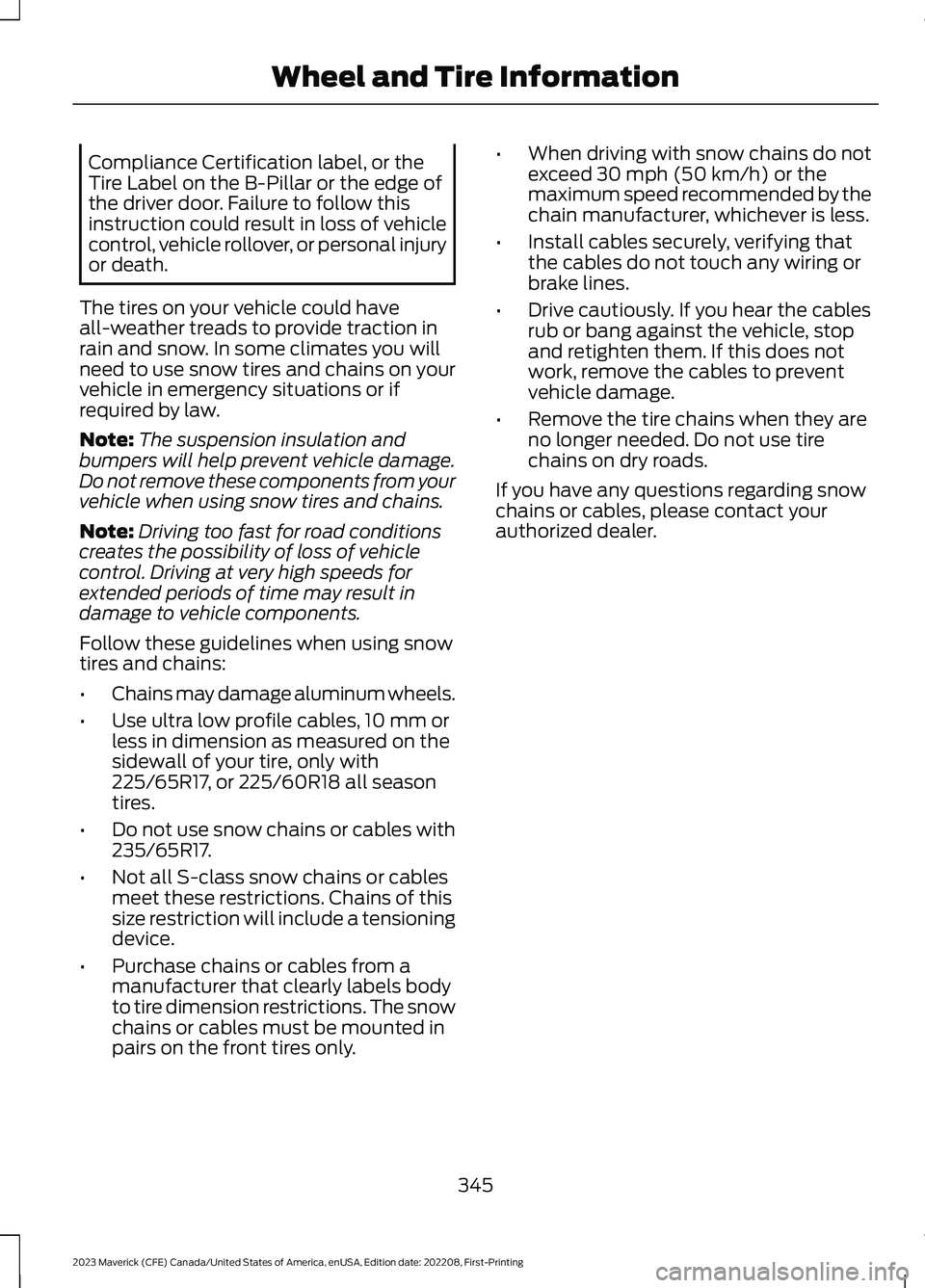
Compliance Certification label, or theTire Label on the B-Pillar or the edge ofthe driver door. Failure to follow thisinstruction could result in loss of vehiclecontrol, vehicle rollover, or personal injuryor death.
The tires on your vehicle could haveall-weather treads to provide traction inrain and snow. In some climates you willneed to use snow tires and chains on yourvehicle in emergency situations or ifrequired by law.
Note:The suspension insulation andbumpers will help prevent vehicle damage.Do not remove these components from yourvehicle when using snow tires and chains.
Note:Driving too fast for road conditionscreates the possibility of loss of vehiclecontrol. Driving at very high speeds forextended periods of time may result indamage to vehicle components.
Follow these guidelines when using snowtires and chains:
•Chains may damage aluminum wheels.
•Use ultra low profile cables, 10 mm orless in dimension as measured on thesidewall of your tire, only with225/65R17, or 225/60R18 all seasontires.
•Do not use snow chains or cables with235/65R17.
•Not all S-class snow chains or cablesmeet these restrictions. Chains of thissize restriction will include a tensioningdevice.
•Purchase chains or cables from amanufacturer that clearly labels bodyto tire dimension restrictions. The snowchains or cables must be mounted inpairs on the front tires only.
•When driving with snow chains do notexceed 30 mph (50 km/h) or themaximum speed recommended by thechain manufacturer, whichever is less.
•Install cables securely, verifying thatthe cables do not touch any wiring orbrake lines.
•Drive cautiously. If you hear the cablesrub or bang against the vehicle, stopand retighten them. If this does notwork, remove the cables to preventvehicle damage.
•Remove the tire chains when they areno longer needed. Do not use tirechains on dry roads.
If you have any questions regarding snowchains or cables, please contact yourauthorized dealer.
345
2023 Maverick (CFE) Canada/United States of America, enUSA, Edition date: 202208, First-PrintingWheel and Tire Information
Page 360 of 556
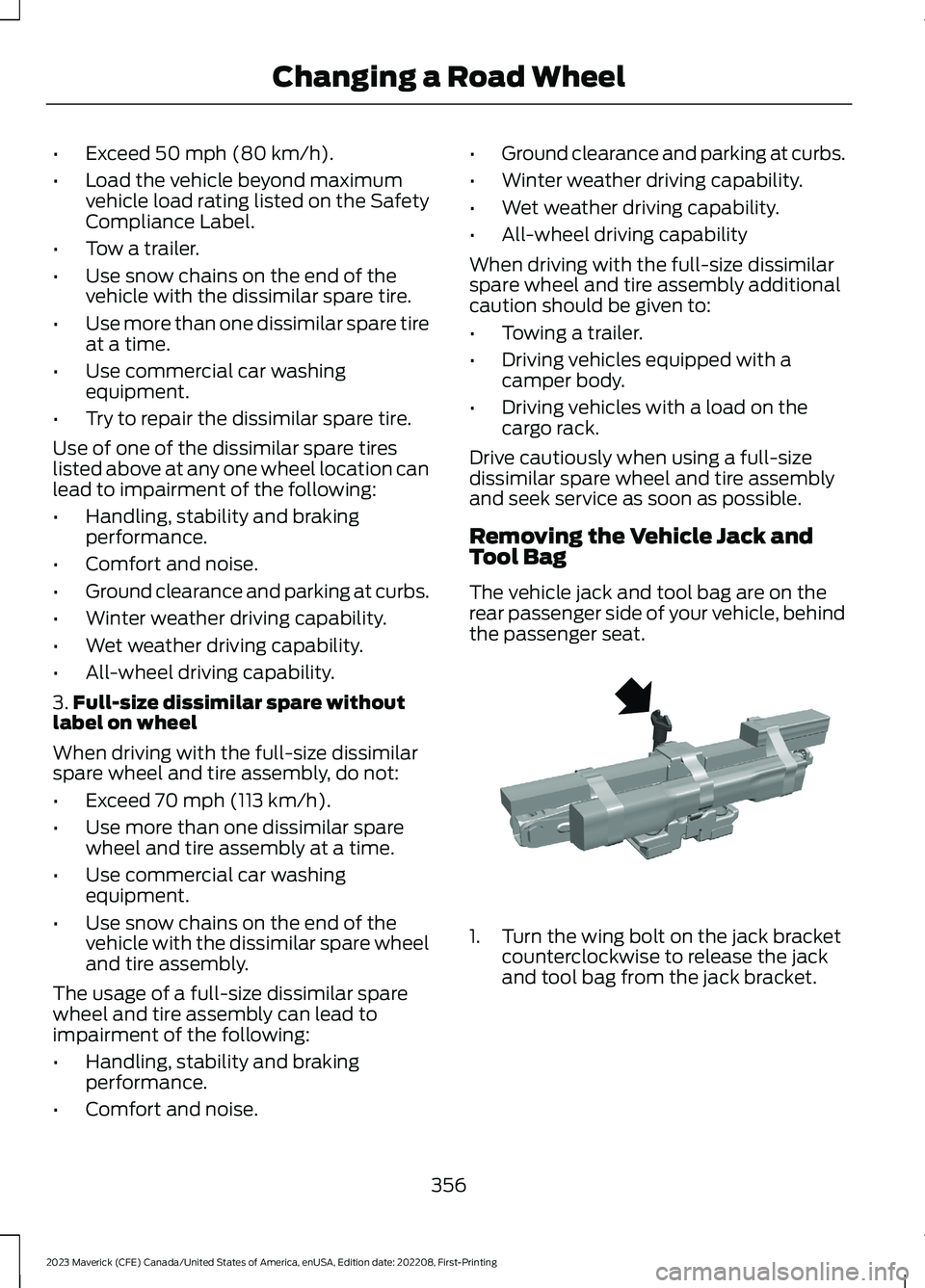
•Exceed 50 mph (80 km/h).
•Load the vehicle beyond maximumvehicle load rating listed on the SafetyCompliance Label.
•Tow a trailer.
•Use snow chains on the end of thevehicle with the dissimilar spare tire.
•Use more than one dissimilar spare tireat a time.
•Use commercial car washingequipment.
•Try to repair the dissimilar spare tire.
Use of one of the dissimilar spare tireslisted above at any one wheel location canlead to impairment of the following:
•Handling, stability and brakingperformance.
•Comfort and noise.
•Ground clearance and parking at curbs.
•Winter weather driving capability.
•Wet weather driving capability.
•All-wheel driving capability.
3.Full-size dissimilar spare withoutlabel on wheel
When driving with the full-size dissimilarspare wheel and tire assembly, do not:
•Exceed 70 mph (113 km/h).
•Use more than one dissimilar sparewheel and tire assembly at a time.
•Use commercial car washingequipment.
•Use snow chains on the end of thevehicle with the dissimilar spare wheeland tire assembly.
The usage of a full-size dissimilar sparewheel and tire assembly can lead toimpairment of the following:
•Handling, stability and brakingperformance.
•Comfort and noise.
•Ground clearance and parking at curbs.
•Winter weather driving capability.
•Wet weather driving capability.
•All-wheel driving capability
When driving with the full-size dissimilarspare wheel and tire assembly additionalcaution should be given to:
•Towing a trailer.
•Driving vehicles equipped with acamper body.
•Driving vehicles with a load on thecargo rack.
Drive cautiously when using a full-sizedissimilar spare wheel and tire assemblyand seek service as soon as possible.
Removing the Vehicle Jack andTool Bag
The vehicle jack and tool bag are on therear passenger side of your vehicle, behindthe passenger seat.
1.Turn the wing bolt on the jack bracketcounterclockwise to release the jackand tool bag from the jack bracket.
356
2023 Maverick (CFE) Canada/United States of America, enUSA, Edition date: 202208, First-PrintingChanging a Road WheelE352020
Page 555 of 556
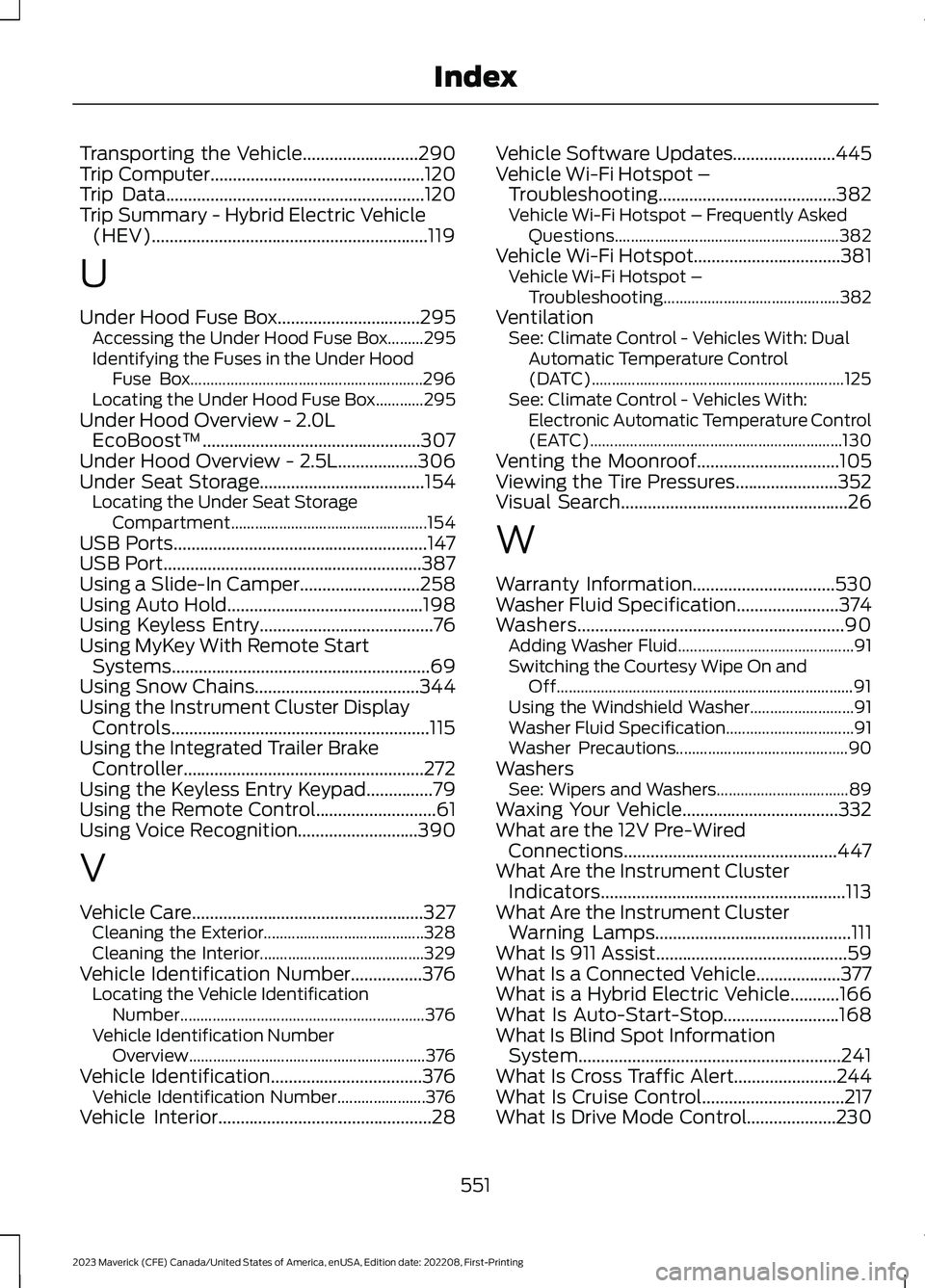
Transporting the Vehicle..........................290Trip Computer................................................120Trip Data..........................................................120Trip Summary - Hybrid Electric Vehicle(HEV)..............................................................119
U
Under Hood Fuse Box................................295Accessing the Under Hood Fuse Box.........295Identifying the Fuses in the Under HoodFuse Box..........................................................296Locating the Under Hood Fuse Box............295Under Hood Overview - 2.0LEcoBoost™.................................................307Under Hood Overview - 2.5L..................306Under Seat Storage.....................................154Locating the Under Seat StorageCompartment.................................................154USB Ports.........................................................147USB Port..........................................................387Using a Slide-In Camper...........................258Using Auto Hold............................................198Using Keyless Entry.......................................76Using MyKey With Remote StartSystems..........................................................69Using Snow Chains.....................................344Using the Instrument Cluster DisplayControls..........................................................115Using the Integrated Trailer BrakeController......................................................272Using the Keyless Entry Keypad...............79Using the Remote Control...........................61Using Voice Recognition...........................390
V
Vehicle Care....................................................327Cleaning the Exterior........................................328Cleaning the Interior.........................................329Vehicle Identification Number................376Locating the Vehicle IdentificationNumber.............................................................376Vehicle Identification NumberOverview...........................................................376Vehicle Identification..................................376Vehicle Identification Number......................376Vehicle Interior................................................28
Vehicle Software Updates.......................445Vehicle Wi-Fi Hotspot –Troubleshooting........................................382Vehicle Wi-Fi Hotspot – Frequently AskedQuestions........................................................382Vehicle Wi-Fi Hotspot.................................381Vehicle Wi-Fi Hotspot –Troubleshooting............................................382VentilationSee: Climate Control - Vehicles With: DualAutomatic Temperature Control(DATC)...............................................................125See: Climate Control - Vehicles With:Electronic Automatic Temperature Control(EATC)...............................................................130Venting the Moonroof................................105Viewing the Tire Pressures.......................352Visual Search...................................................26
W
Warranty Information................................530Washer Fluid Specification.......................374Washers............................................................90Adding Washer Fluid............................................91Switching the Courtesy Wipe On andOff..........................................................................91Using the Windshield Washer..........................91Washer Fluid Specification................................91Washer Precautions...........................................90WashersSee: Wipers and Washers.................................89Waxing Your Vehicle...................................332What are the 12V Pre-WiredConnections................................................447What Are the Instrument ClusterIndicators.......................................................113What Are the Instrument ClusterWarning Lamps............................................111What Is 911 Assist...........................................59What Is a Connected Vehicle...................377What is a Hybrid Electric Vehicle...........166What Is Auto-Start-Stop..........................168What Is Blind Spot InformationSystem...........................................................241What Is Cross Traffic Alert.......................244What Is Cruise Control................................217What Is Drive Mode Control....................230
551
2023 Maverick (CFE) Canada/United States of America, enUSA, Edition date: 202208, First-PrintingIndex